|
this church now has its own page |
||
|
Santa Caterina Via Cesare Battisti |
||
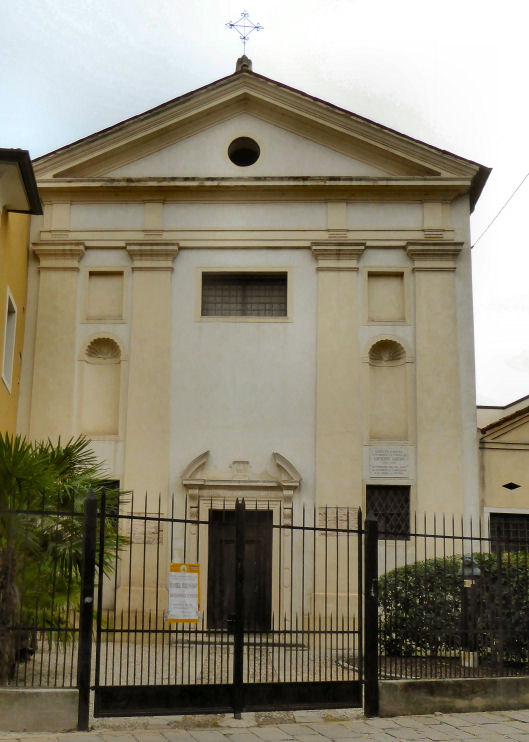 History A church was here by 1144, dedicated to Saint Catherine of Alexandria. As early as 1623 Augustinian nuns from the monastery of Santa Maria Maddalena took over the church and built a convent buildings. Rebuilding took place at the end of the 17th century. The children of Galileo Galilei were baptised here, and the church ontains the tombs of the violinist and composer Giuseppe Tartini and his wife to the right of the baroque high altar. Following Napoleonic suppression the church lost its parish function and the Augustinian nuns were expelled. The monastery became an orphanage, amongst other uses, and the church became a subsidiary in the parish of Santa Sofia and later closed. After considerable restoration wotk the church and convent are now used by Padua University. The church is sometimes used for concerts, thanks to the Tartini connection. Interior 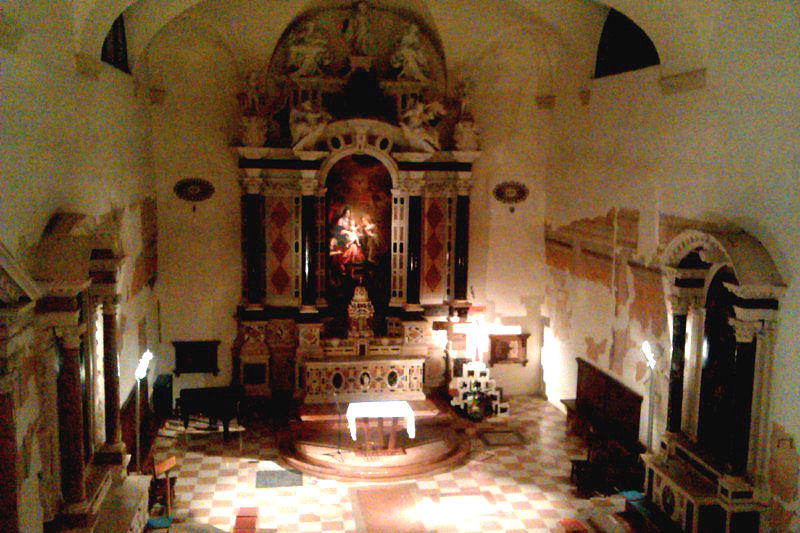 A small aisleless space with two ornate marble side-altars each side. The high altar has an altarpiece depicting the Mystic Marriage of Saint Catherine by Marcantonio Bonaccorsi. On the side walls flanking the high altar there are early-13th-century fresco fragments. Over the second altar on the right is an altarpiece of Saints Sebastian, Roch and Charles by Pietro Damini, said to be the the artist's final work, completed during the plague of 1630, which led to his death. It was brought here in the mid-19th century from the church of San Biagio, then being demolished. Opposite is a Holy Family attributed to Claudio Ridolfi. Elsewhere a niche contains an 18th-century processional statue of Saint Catherine. Over the 17th-century confessionals there is a 17th-century lunette Supper at Emmaus and an Annunciation by Bartolomeo Moro dated 1718, which features a portrait of the commissioning parish priest. To the left of the entrance once stood the baptismal font in which the children of Galileo Galilei were baptized, which is now in the church of Santa Sofia.
Odd claim Interior
photo from Wikipedia by UrbisPatavii |
||
|
Santa Croce Corso Vittorio Emanuele |
||
|
Interior Campanile Opening times |
||
|
History A church was on this site in the 10th century, it is said, but the current church dates to Baroque rebuilding in the 18th century. Interior A not very long - almost square - nave, with an altar and two confessionals each side, a square choir, stone saints in niches and long canvases in the choir of the Resurrection and ?Saint Lucy. A painting of Saint Luke as a painter, attributed to Giambattista Tiepolo, is reported to be here, but was not to be seen on my visit. Lost art Benedetto Diana's Virgin and Child Enthroned with Saints Jerome, Benedict, Justina, and Mary Magdalene (see below), now in the Accademia in Venice, acquired, following the Napoleonic Suppression, in 1812. A carved lunette of the Virgin and Child by the studio of Pietro Lombardo is in the Eremitani Civic Museum. 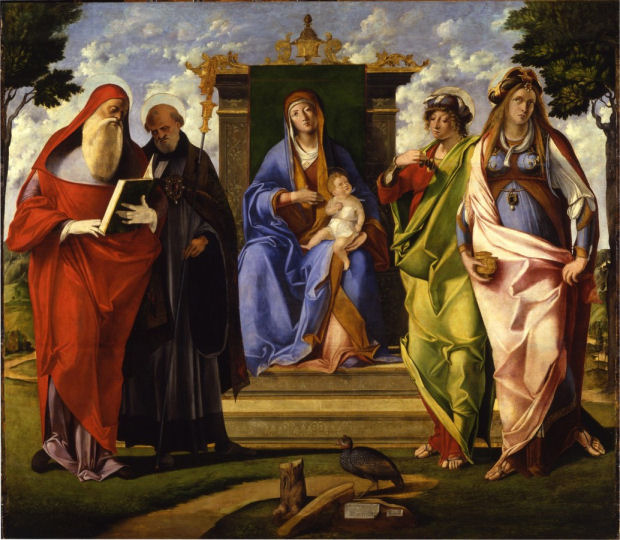
Scuola di San Rocco
Opening times |
|
|
|
Santa
Maria dei Colombini |
||
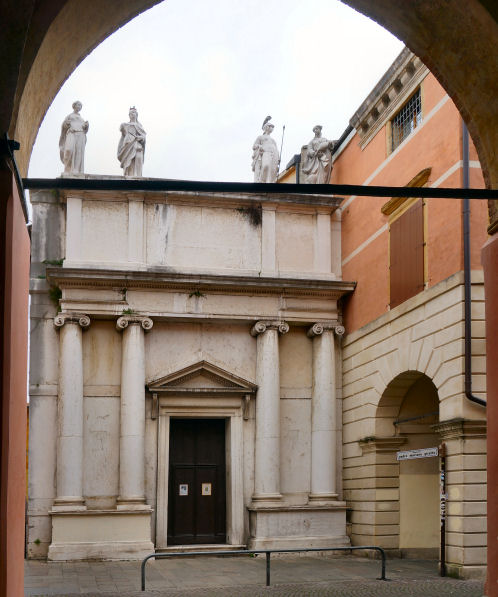 History Built over an ancient oratory c.1748. The architect was the Venetian Thomas Temanza, more famous for Venice's cylindrical church of Santa Maria Maddalena (where he is buried) and San Servolo. Here he provided Padua with an early example of a neo-classical fašade.
Interior |
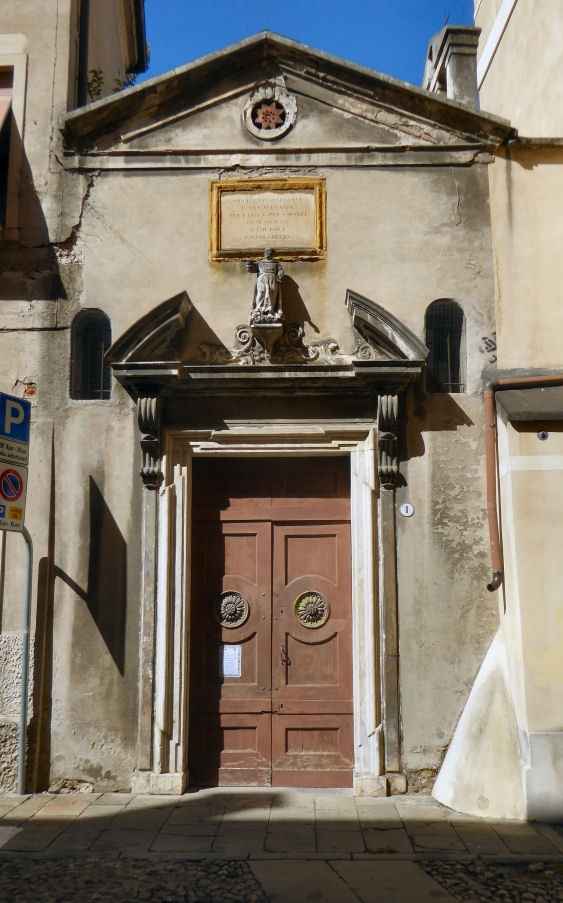 History A church here dates to the 14th century, where it is said that the Colombini met, they being a group of penitents devoted to Saint Anthony of Padua who formed a confraternity. They were suppressed by Napoleon and with the oratory set for demolition it was acquired in 1810 by Conti Alessandro and Francesco Papafava de 'Carraresi, which resulted in the building as it appears now, with works of 1817. Reopened to the public in June 2017 by the Archconfraternity of Saint Anthony of Padua, details here. |
|
|
History Built from 1372, financed by Fina Buzzacarini, the wife of Francesco I da Carrara, who also commissioned Giusto de' Menabuoi to decorate the Baptistery of the Duomo as a mausoleum for the couple. The church was built on the site of the house of Niccol˛ da Carrara, which was demolished. Niccol˛ was the traitorous grandfather of Francesco I and the story goes that Fina, a very pious woman, chose to build on this site to punish him for his betrayal. Or it may have been to celebrate the marriage of one of her daughters. When Fina died in 1378 responsibility for completing the church passed t0 her sister Anna, the abbess of the San Bernadetto. In 1392 Fina's son Francesco Novello, who had succeeded his father as duke, gave the church to the Servites, which was when it acquired its current name. The Renaissance portico along the left side of the church was added in 1511 by Bartolomeo Campolongo, using ten red marble octagonal columns from the demolition of the original 14th-century chapel of Saint Anthony in the Santo. The church was part of a complex that included the convent of the Servites, the Oratory of Saint Homobonus and the Oratory of the Guild of Saint Mary of the Servites. Confiscated in 1806, the government only returned the church to ecclesiastical authorities in 1963, 157 years later, as a plaque in the church records. Interior Aisleless and quite tall with white walls, a wooden corbelled roof and some unspecial monuments to worthies and a nice variety of 14th-16th century fresco fragments spaced around. The 16th-century fresco of the Virgin and Child with Saints Roch Anthony Joachim and Anna on the back wall to the right is the most complete. It is now attributed to Dominico Campagnola (previously it was said to be by Girolama del Santo) and dated to the 1530s but looks to have suffered some inexpert touching up. The two frantic 17th century canvases above are by Matteo Ghidoni. The dominant feature is the very Baroque Altar of Our Lady of Sorrows which faces you as you enter the side door (see photo right). It is by Giovanni Bonazza from 1703-10 and houses a statue of The Virgin from the late 14th century by Rinaldo di Francia. It was previously erroneously attributed to Donatello. There's a small 'Scuola di Mantagna' Pieta fresco contained in a Lombardesque tabernacle to the right of the baroque altar, it was previously said to be by Jacopo da Montagnana, a Paduan painter who Vasari said studied with Bellini, but whose work indeed looks more influenced by Mantagna. It is now said to be by Pietro Calzetta (1430/40-1486) and is called The Man of Sorrows (Christo Passo) Between the Virgin and St John. There's also God the Father in the lunette above. There's a polygonal apse with two square side chapels. Flanking the apse are canvases of Saint Andrew and Saint Peter by Palma Giovane. In the chapel to the left of the apse is a Crucifix, recently restored. The church now says that it's by Donatello, other sources have said that it's by an unknown artist inspired by Donatello, but recent scholarship seems to go with the Donatello attribution, made during the decade he spent working at the Santo. The face looks very Donatello. It was painted to simulate bronze in the 19th century but restoration 2012-2015 restored the flesh tone. It is venerated, though, because in 1512 blood is said to have seeped from the face and side of the statue. Originally it stood on the tramezzo (rood screen) but was moved to its current position after the bleeding episode and 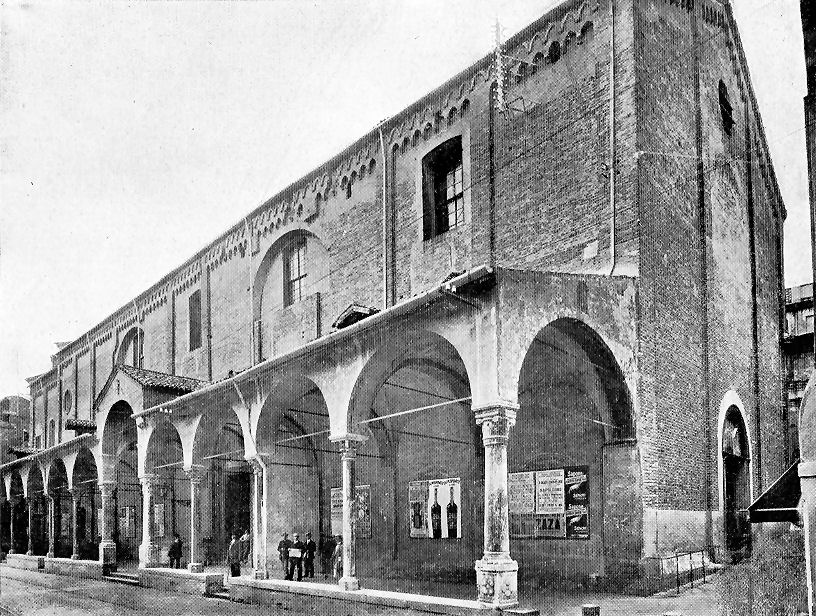 subsequent veneration.
Frescos of The Passion in this chapel are barely visible and the
sculpted surround is by Lorenzo Canella (1884-1956) subsequent veneration.
Frescos of The Passion in this chapel are barely visible and the
sculpted surround is by Lorenzo Canella (1884-1956)Lost art An altarpiece showing the Virgin Misericordia, with the Child and Saints, by an anonymous Paduan artist of the late 15th century, is in the Eremitani Civic Museum
|
|
|
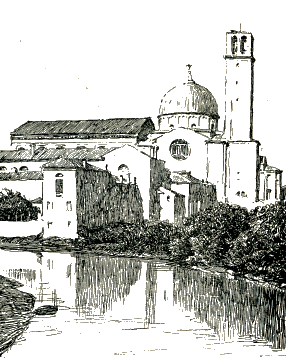 History The Carmelites were established around here, an area dominated by mills, in the later 13th century and work on their church here began in 1309, on the site of an oratory built in 1212. The original church had a single nave, a ship's-keel wooden roof and six chapels. In 1491 heavy snow and an earthquake caused the roof to collapse. Lorenzo da Bologna and Pietro Antonio degli Abati were employed to rebuild. The church was completed in 1523 by Biagio Biagio, the work retaining much of the original structure, with renaissance embellishments. (It is said that Lorenzo's dome is visible in Giorgione's Tempest.) Further damage, from an earthquake in 1695 (following which the roof was replaced and the fašade, and main door were completed) and from fire following a firework display celebrating the new pope in 1800. Also bomb damage in 1917 by the Austrians (the dome was destroyed and rebuilt in 1931) and in 1944 by the Allies, the church being close to the railway station. Fašade Another unfinished fašade, punctuated by holes where the scaffolding poles were inserted, called putlogs in English, because that was where they put the logs to support the scaffolding. The doorcase dates to 1412, with statues by Bonazza added in 1736/7. Interior Big, tall and aisleless, barrel-vaulted with six substantial chapels down each side, variously (mostly baroquely) filled. Fresco roundels, mostly, in the spandrels on the wall between them. A huge triumphal arch over the high altar at the end of a deep choir which has a large frescoed cupola above on a shallow drum, with a deep lunette arch over the arch. The choir area is covered in frescos of Pre-Raphaelite appearance. No transept. The painted altarpieces inside the chapels (the first and third on each side) and the panels elsewhere (large and square over each chapel and on the back wall) are mostly 17th century and not special. Many are by Bissoni and Varotari (aka Il Padovanino). The last altar on the right contains what is said to be one of the best by the latter: Christ with Zebedee's Mother, originally from church of San Giacomo. There are no labels on the art and no guidebook was available. 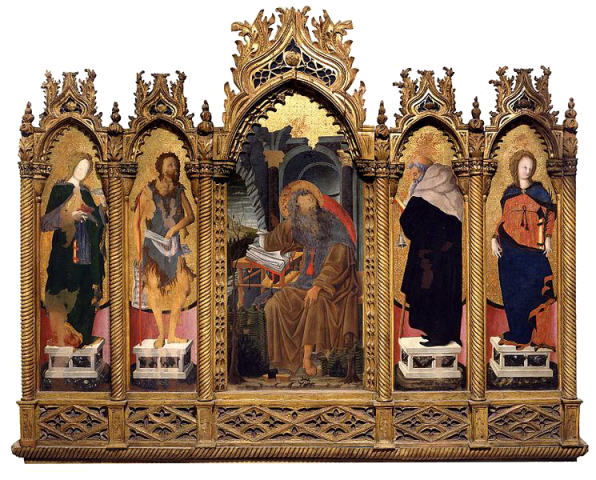 Lost art The De Lazara Polyptych of 1449-52 (see right) signed by Francesco Squarcione, Mantegna's master, is now in the Padua Museo Civico. It's one of the rather second-rate painter's better works, made for Leone de Lazara's family chapel here. The central panel shows Saint Jerome in his Study, with four side panels showing saints against a gold ground - Lucy, John the Baptist, Anthony Abbot and Justina of Padua. The church in art This church can be seen. in the far distance, in the centre of Canaletto's The Porta Portello, Padua of c.1741/2, now in the Washington National Gallery.
The stylistic transition from Giulio
Campagnola to his son and Girolamo del Santo here supposedly illustrates
the change in dominant influence from Mantegna to Titian, with Stefano dell'Arzere's work said to show the movement towards to mannerism.
|
|
|
|
Santa Maria del Torresino |
||
|
|
||
|
Santa Maria della CaritÓ |
||
|
History In 1512 Pope Leo X granted Observant Dominican friars permission to build a convent complex here, as their previous monastery in Bassanello had been destroyed during the Cambrai war of 1509 to make way for a new city wall. The church here was built between 1531 and 1585 to designs by Lorenzo da Bologna and was considerably extended during work adding a fašade in 1710. These works, involving designs by Giovanni Maria Falconetto, probably, went slowly due to a shortage of cash, and the church ended up less large and ambitious than intended. The Observant Dominicans were suppressed in 1771 and in the following year the convent passed to the Zitelle Povere (Poor Spinsters), then the Ospedale dei Mendicanti. It was later annexed to the Orfanotrofi Riuniti. (Reunited Orphanages). Only the church remains and is currently owned by SPES (Servizi alla Persona Educativi and Sociali) as a restoration laboratory managed by the Veneto Institute for Cultural Heritage. The fašade Over the door is an oval window decorated with four cherubs, with above, in the attic story, a statue of the Virgin and Child by the workshop of Giovanni Bonazza, who are also responsible for the statues flanking the door depicting Saint Bonaventure and probably Pope Clement XIII. Interior A single nave with a lowered barrel vault and 18th-century polychrome marble altars. The paintings on the altars include a Nativity of the Virgin of 1590 attributed to Dario Varotari, and 17th/18th century works by Pietro Damini, Girolamo Brusaferro and Antonio Marini. Flanking the high altar there are marble statues of Saint Domenic and Saint Vincent Ferrer by Giovanni Bonazza. |
|
|
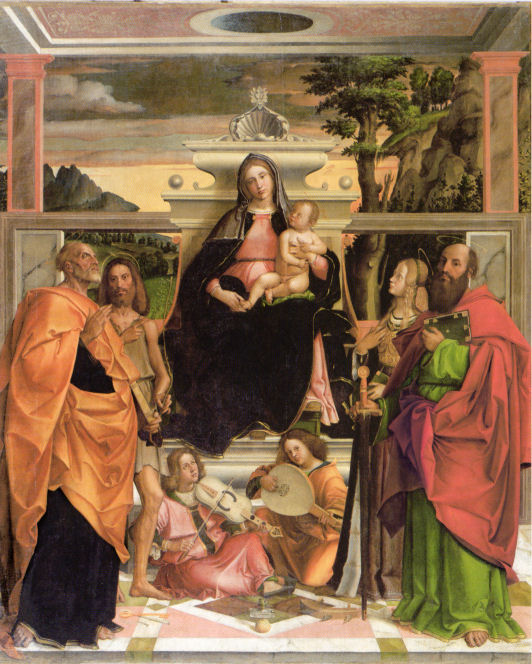 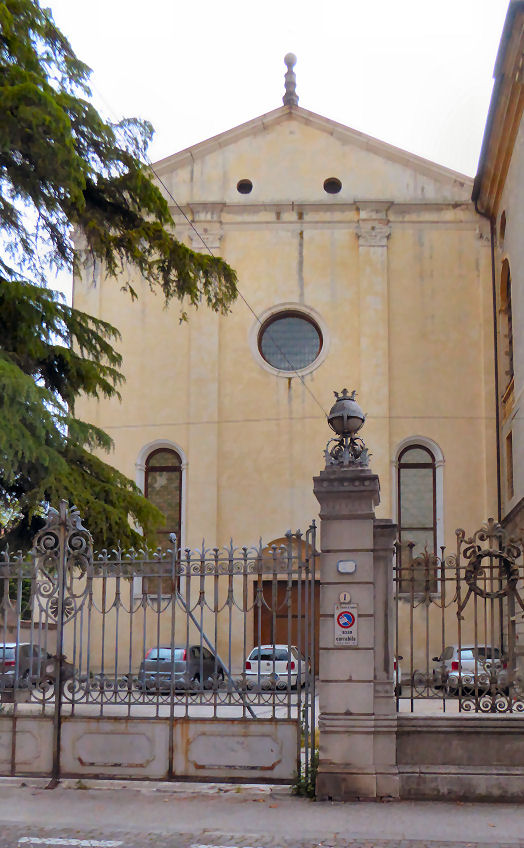 History Renaissance in style, built in 1436 at the expense of Domenico Campolongo, a Paduan nobleman, and enlarged in 1525. Art In the refectory here, a large Crucifixion by Michele da Verona dated 28th March 1505, itself a smaller version of a work of 1501 in San Giorgio in Braida in Verona, both commissioned by the Secular Canons of the Blessed Lorenzo Giustiniani. Impressive frescoes by Domenico Campagnola, a Paduan pupil of Titian. Two(?) paintings by Bartolomeo Montagna, one being the Virgin and Child Enthroned, with Saints Peter, John the Baptist, Catherine, Paul and Angel Musicians (c.1512) over the high altar (see left) which was restored in 2002. It also has wings depicting Saints Lawrence and Francis. An Entombment, signed by Jacopo Bassano and dated 1574 on the stone, bottom centre, over the last altar on the left wall. A Sacra Conversazione by Antonio Vassilacchi, the Greek painter and pupil of Paolo Veronese, also known as L'Aliense (the alien) who worked mostly in Venice, especially in the Doge's Palace after the 1577 fire. |
||
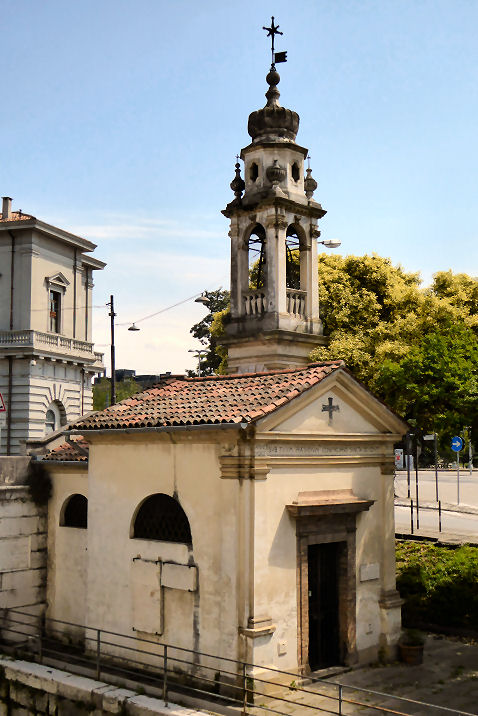 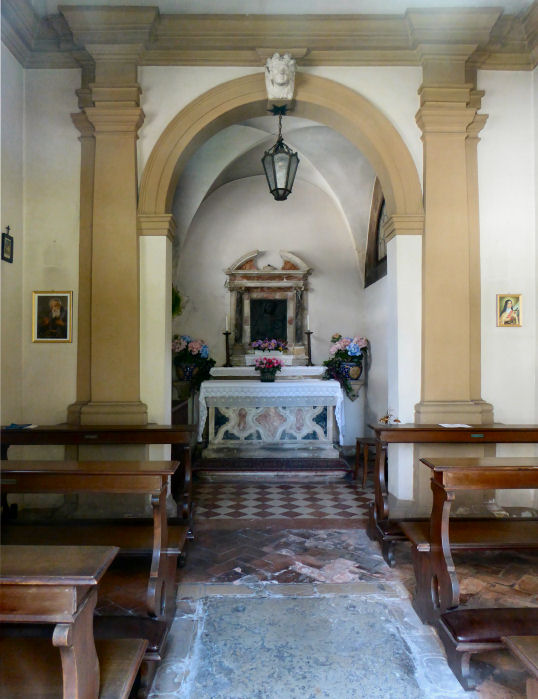
The church |
||
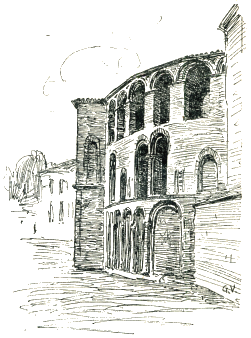 History HistoryVarious traditions have it that this is the site of the oldest church in Padua, founded by Saint Prosdocimus, the first bishop of Padua, in the 4th century, or that it was founded in the 8th or 9th century, on the site of a temple to Mithras, or maybe Apollo, and that it was the original cathedral of Padua. It was crumbling in 1106, though, and the current church is mentioned first in a document dated 9th February 1123 where Bishop Sinibaldo urges the speeding up of the building work, which had begun in 1109 and suffered delays following the earthquake of 1117. Work was completed in 1127 with a Romanesque facade but retaining the earlier church's apse parts of which were found, in the crypt, to date to the 9th century. There were 14th century Gothic additions too, and much restoration, including the removal of a building which was 'leaning on it' in the 1950s. This major work was to restore the church to its original appearance, removing mannerist and baroque decoration. Until 1957 the church housed the relics of the Blessed Beatrice I Este (1578) and of the Blessed Elena Enselmini, the latter having been moved here from the church of the Blessed Elena in 1810. Initially run by Augustinians monks, the church had passed to Benedictine nuns by 1517. In the 16th century it became a parish church. The nuns were expelled during the Napoleonic suppressions in 1806ľ1810 and the convent was acquired by the state. The church has recently returned to being a parish church governed by the secular clergy of the Diocese of Padua. The fašade A thing of niches, blind arcades and hanging arches (it might remind you of Torcello) it dates to the early 12th century. Some niches have fragments of 14th-century frescoes. The mullioned window at the top is from the 20th-century restoration, the large oculus being 14th century and part of the work instigated by Bishop Stephen from Carrara. . Interior Pale brick and plain, with a nave and two aisles separated by rows of pillars, columns on pillars, and two columns - they vary much but match across the nave. A groin-vaulted ceiling of the 14th century, with decorated ribs and arches. Two side altars each side. The result of the major restoration in the 1950s which returned the building to its original appearance, removing 16th and 17th century accretions. The plastered roof dates from the late 14th century renovation work A burst of fresco in the vaults over the left-hand aisle of the ambulatory. Some 13th/14th-century anonymous fresco fragments, including a 14th-century lunette of the Virgin and Child Enthroned with Saints and Donors over the apse (see photo below right). The deep early-medieval apse was restored in 1852 and has an ambulatory which narrows to nothing at the back. A Vision of San Francesco di Paola by the Paduan artist Giovanni Battista Cromer (1665 - 1745) was restored in 2002. It sits over the altar dedicated to the Blessed Beatrice D'Este in the right-hand aisle. In the left aisle is an altar with a PietÓ by Egidio from Wiener Neustadt. Campanile Romanesque/Gothic, dated 1296, adjacent to the apse. Two notable baptisms and a funeral The baptismal font here was used to baptize Livia and Gianvincenzo, offspring of Galileo Galilei. It was originally in the church of Santa Caterina. Also here is the tomb of the writer Ludovico Cortusio who in his will famously forbade his friends and relatives from weeping at his funeral, on pain of losing their inheritance, and promised that the one who laughed most would become his principal heir. He banned black drapes and stipulated flowers and greenery, music and minstrels to replace tolling bells. He ordered his bier, covered in bright fabrics, be carried by 12 young girls dressed in green and singing songs. He wanted all the town's monks to attend, except those whose robes were black. He died on 17th July 1418 and his wishes were carried out, giving the ceremony the appearance of a wedding rather than a funeral. Lost art An altarpiece, a Sacra Conversazione, painted for the high altar in this church in 1448 by Mantegna. It is said to have been his first commission and according to Vasari was painted when he was 17. Commissioned by the Confraternity of St Anthony on behalf of a recently-deceased baker called Bartolomeo, it was dismembered in the 17th century and is now lost. 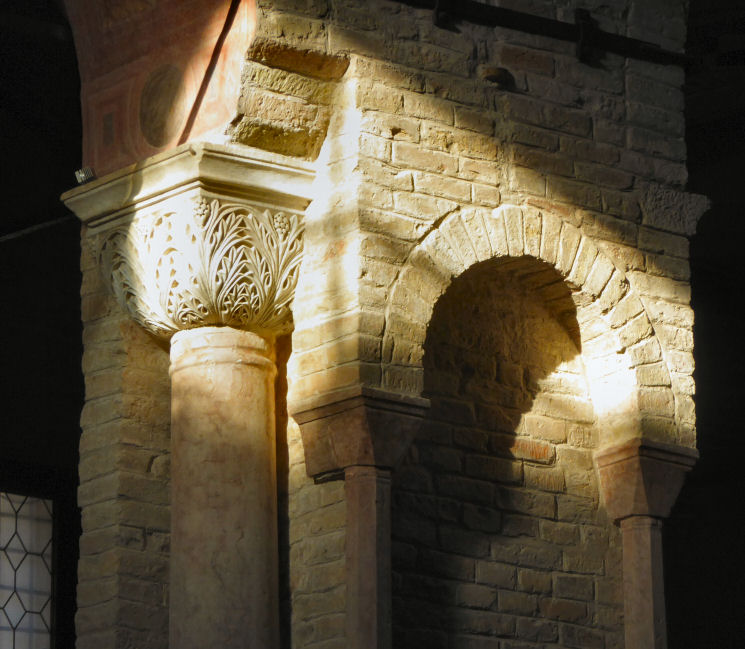 Opening times Mon/Tues 9.30-11.30, 16.00-19.30 Weds-Sat 7.30-11.30, 16.00-19.30 Sunday and feast days 9.00-12.30, 18.00-20.00 |
|
|
|
Campanile |
|
|
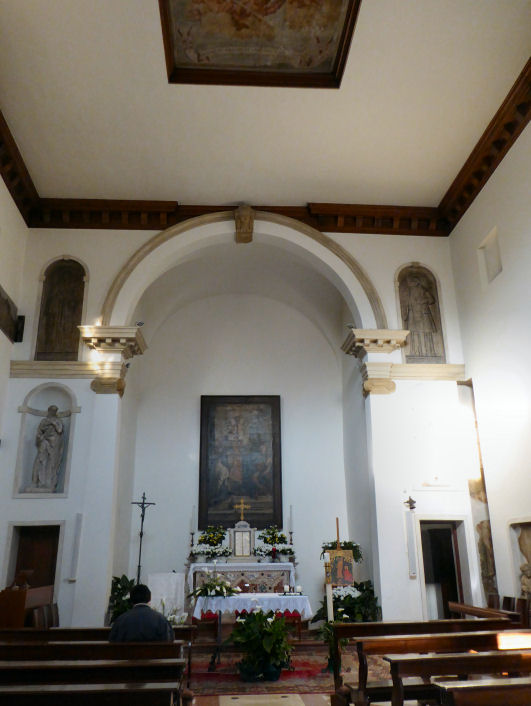 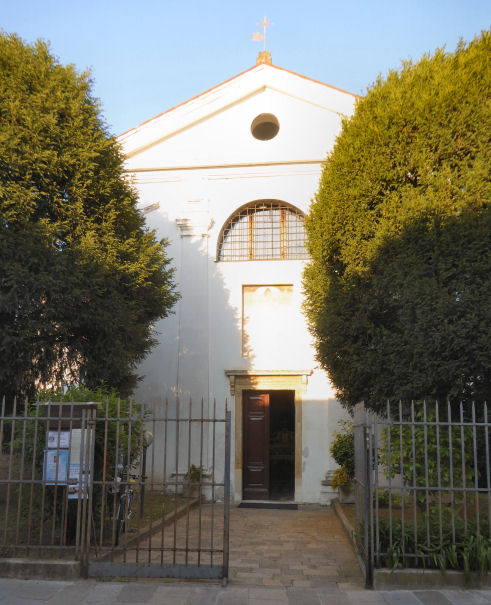 History Built on the site of a large burial ground, it is said, the church here became a parish church in 1308. San Massimo was the second bishop of Padua. The small medieval church underwent rebuilding in the 16th and 17th centuries, due to the popularity of the area for patrician family houses and to a charismatic parish priest, Father Giuseppe Cogolo, who commissioned paintings by Giovanbattista Tiepolo between 1742 and 1745. Parish church status was lost during the Napoleonic suppressions and the church was closed to worship. During World War II it suffered bomb damage. It reopened as a university chapel after a major restoration in the 1990s, although it suffered much loss of fittings during its years of closure. Interior Three altarpieces from c.1745 by Giambattista Tiepolo - Saint John the Baptist, The Flight into Egypt and Saints Maximus and Oswald, the last being reputedly the best. Also the tomb of the famous physician Giovan Battista Morgagni.
|
||
|
Mystery
church in
via Suor Elisabetta Vendramini Saint Joseph?  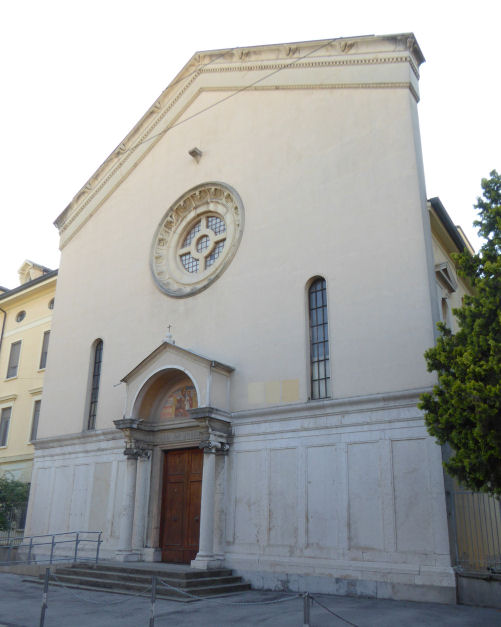 San Giuseppe? Joseph church interior 2017 1080220/1 |
Mystery church
in Corso Vittorio
Emanuele II/Via Alberto Mario
|
|
|
|
||
|
Sant'Anna North of the town is the Sanctuary dell'Arcella, a Gothic Revival church, completed in 1931 to designs by Eugenio Maestri, built on the site of a hospice, run by Clarissan nuns, which had been established by Saint Francis of Assisi himself in 1227. At this time the hospice was some distance outside the city walls. It was here that Saint Anthony died on the evening of June 13, 1231. Still run by Conventual Franciscans, and now a parish church. |
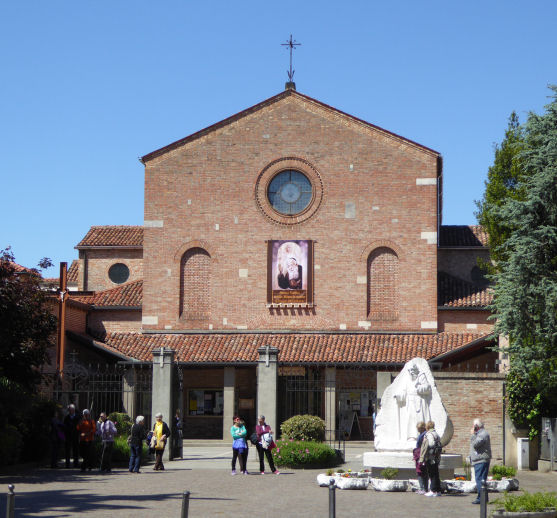
Jacopo Bellini was commissioned in 1430 to paint a fresco of the
Archangel Michael for the church of San Michele in Padua. Two
panels by Lazzaro Bastiani depicting the Archangels Michael and Gabriel
are said to be the organ doors from the church of San Michele. |
|
|
Lost |
||
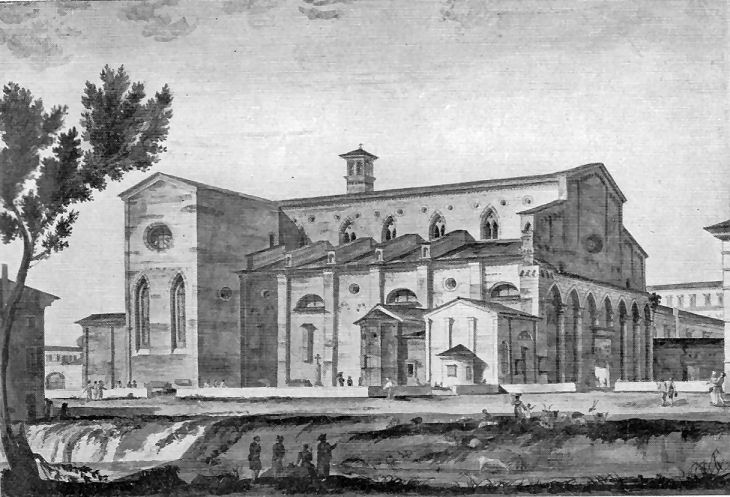 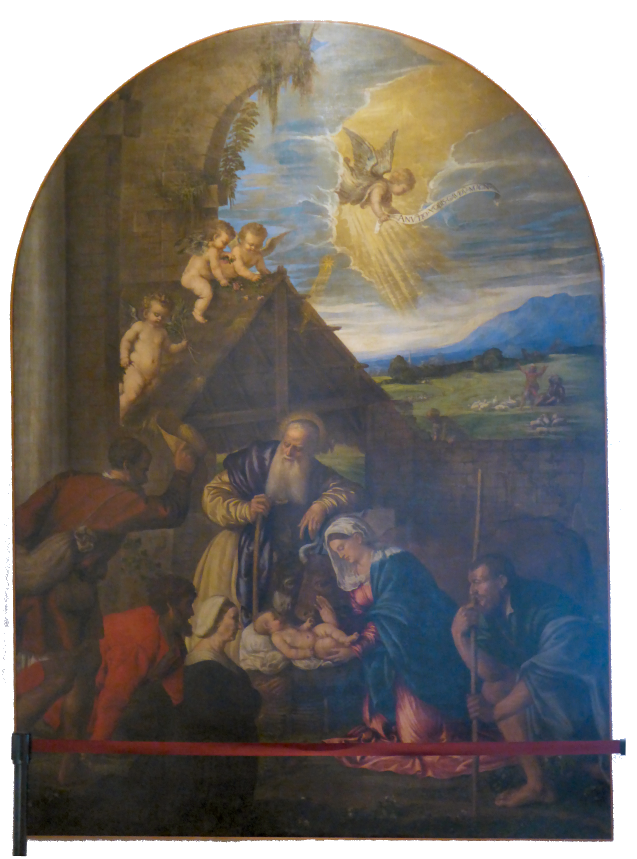 History Founded in 1226 by Dominicans on the west bank of the Bacchiglione River. A small oratory already on the site, dedicated to Santa Maria di Valverde served as a chapel initially. The new large brick church was consecrated in 1303. This church became something of a mausoleum for the Carrara lords and others from the local elite. Twelve trachite columns separated the nave from the aisles, and there were nineteen altars, which would eventually be topped by altarpieces of the 16th/17th centuries. There was a Donatello Crucifix, a polychrome terracotta PietÓ by Giovanni Minello and works by Antonio Bonazza and Tommaso Allio. Suppressed in 1806 and demolished by the Austrians in 1829. All that remains is one of the two cloisters - it became a barracks and looks ruined, but still in use. The refectory of the barracks evidently still has a fresco fragment of a Dead Christ with Two Angels attributed to Guariento. Lost art The tombs of Jacopo II da Carrara and Ubertino da Carrara by Andrioli di Santi (now in the Eremitani church) were originally sited in the presbytery here, along with the fresco of Coronation of the Virgin with the two Carrara princes, by Guariento. An Adoration of the Shepherds with a Donor by Stefano dell'Azare (see right) is now in the Eremitani Civic Museum. As is the Resurrection of Christ with Mary Magdalene and Saints Augustine, Dominic and Andrew by Domenico Campagnola, and studio. The Deposition of Christ, with a separate figure of Carlotta of Lusignano, is a terracotta group made after 1483 by Giovanni de Fondulis. It was commissioned by Marietta of Patras, the Greek mistress of King John II of Cyprus, in memory of her granddaughter Carlotta of Lusigano, the illegitimate daughter of King James II of Cyprus. It was installed in the altar of San Salvatore, erected in 1483, in the left transept here. Carlotta's tomb was at the foot of this altar. It is now in the Isabella Stewart Gardner Museum in Boston. |
||
|
Sant'Egidio Lost art Ecce Homo with Angels, Saint George and Jerome and the Donor Battista Pozzo and his wife by Dario Varotari is in the Eremitani Civic Museum. P1080141 Santissima TrinitÓ Destroyed in 1509 during the siege of Padua with the altar transferred to the church of San Giacomo in 1530. Lost art The Lamentation over the Dead Christ, a marble relief by Bartolommeo Bellano, a pupil of Donatello, from c.1470-5 (see right) was made for this church Following the destruction of the church in 1509, the relief was moved in 1530 to the church of San Giacomo and after that church was suppressed (between 1811 and 1817) into private hands. A Milanese dealer sold it to the V&A in London in 1878, where it remains. |
Santo Stefano Lost art An odd Virgin and Child Enthroned with Four Saints attributed to Francesco Benaglio from c.1475 from the convent here has recently gone on display in the new 15th century rooms in the Accademia in Venice. The Martyrdom of Saint Stephen and The Adoration of the Magi by Pietro Damini in the Eremitani Civic Museum P1080144/P1080148
|
|
|
|